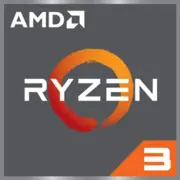AMD Ryzen 3 1200

AMD Ryzen 3 1200 in 2025: A Budget Processor for Basic Tasks
Introduction
The AMD Ryzen 3 1200 processor, released in 2017, was one of the first building blocks of the Ryzen lineup, offering affordable 4-core performance. In 2025, it remains a niche solution for ultra-budget builds. Let's explore its relevance, strengths and weaknesses, and potential use cases.
Key Specifications: An Outdated but Functional Platform
Architecture and Technology Process
The Ryzen 3 1200 is built on the first-generation Zen microarchitecture (codename Summit Ridge) with a 14nm process technology. It is a 4-core CPU with no multithreading support (4 threads), with a base frequency of 3.1 GHz and an overclocking potential of 3.4–3.8 GHz (depending on the specimen). The L3 cache size is 8 MB, and the TDP is 65 watts.
Performance
- Geekbench 6: 983 points (single-threaded), 2833 (multi-threaded).
- Real-world tasks:
- Office applications: operates smoothly (Word, Excel).
- Video players: decodes 4K H.264 with caveats (possible stuttering without hardware acceleration).
- Gaming: CS:GO — 80–100 FPS on low settings (paired with a GTX 1650), but modern AAA titles (e.g., Cyberpunk 2077) run only at minimum settings with 30–40 FPS.
Key Features
- Overclocking capability (on motherboards with B350/X370 chipsets).
- Low power consumption.
- Support for PCIe 3.0 (relevant for NVMe SSDs, but PCIe 4.0/5.0 graphics cards will be limited).
Compatible Motherboards: AM4 Socket and Details
Socket and Chipsets
The processor uses the AM4 socket. Compatible chipsets include:
- A320: Basic variant without overclocking (price of new boards in 2025 — $50–70).
- B350/X370: Supports overclocking and SLI/CrossFire (new models are rare, price — from $80).
Selection Features
- BIOS: Many boards released in 2023–2025 do not support older Zen 1 processors. Look for models with guaranteed compatibility (for example, ASRock B450M-HDV R4.0).
- Recommendations:
- For upgrades: B450/X470 (allow future installation of Ryzen 5 5600X).
- For mini-PCs: Mini-ITX format boards (e.g., ASUS Prime A320I-K).
Supported Memory: DDR4 and Its Nuances
Ryzen 3 1200 works with DDR4. Officially supported frequencies go up to 2666 MHz, but with overclocking, it can reach 2933–3200 MHz (depending on the quality of memory and motherboard).
- Recommended Modules:
- 2×8 GB DDR4-3200 (for example, Kingston Fury Beast — $45 for a set).
- For a budget build — 1×16 GB DDR4-2666 ($35).
Important!
Zen 1 processors are sensitive to memory timings. The optimal option is dual-channel mode and low latencies (CL16–CL18).
Power Supply Units: Minimum Requirements
With a TDP of 65 watts, the Ryzen 3 1200 does not require a powerful PSU:
- Without a discrete graphics card: a 300–350 W PSU is sufficient (for example, be quiet! System Power 10 — $40).
- With a graphics card:
- GTX 1650 (TDP 75 W) — 450 W (Corsair CX450 — $55).
- RTX 3050 (TDP 130 W) — 550 W (Seasonic S12III — $65).
Tip: Don’t skimp on the PSU. Even for a budget build, choose models with an 80+ Bronze certification.
Pros and Cons of the Ryzen 3 1200 in 2025
Advantages
- Price: new processors can still be found for $50–70.
- Energy efficiency: ideal for low-power PCs.
- Upgrade possibilities on AM4 (up to Ryzen 5000).
- Simple installation and cooling (the stock cooler is sufficient).
Disadvantages
- No SMT (4 threads compared to 8 for the Ryzen 3 3100).
- Weak IPC by 2025 standards.
- Lack of integrated graphics (a discrete graphics card is needed).
Use Cases: Where It Still Makes Sense
1. Office PCs: working with documents, browsing, Zoom.
2. Home media center: streaming video (1080p/4K via GPU decoding HVEC).
3. Light gaming: indie games, retro console emulators, CS:GO.
4. Servers: NAS or home server based on Linux (thanks to the low TDP).
Practical Example:
A build for parents: Ryzen 3 1200 + 8 GB DDR4 + 256 GB SSD + GT 1030. Cost — about $250. Suitable for browsing the internet and watching movies.
Comparison with Competitors
- Intel Core i3-7100 (2017):
- 2 cores/4 threads, higher IPC, but worse in multi-threaded tasks. Used price — $30–40.
- Intel Core i3-10100F (2020):
- 4 cores/8 threads, Geekbench 6 Multi-Core — ~4200. New — $90.
- AMD Ryzen 3 3100 (2020):
- 4 cores/8 threads, Zen 2, Geekbench 6 Multi-Core — ~4800. New — $100.
Conclusion: The Ryzen 3 1200 lags behind even budget CPUs from 2020–2023, but it wins in price.
Practical Assembly Tips
1. Motherboard: Choose B450/X470 for upgrades. Example: MSI B450 Tomahawk Max II ($90).
2. RAM: 16 GB DDR4-3200 in dual-channel.
3. Storage: An SSD is essential (for example, Kingston A400 480 GB — $35).
4. Cooling: The stock cooler is enough, but for overclocking, consider the Deepcool Gammaxx 400 ($20).
5. Graphics Card: GTX 1650 or RX 6400 for gaming.
Important: Update the BIOS before installing the processor!
Final Conclusion: Who Is the Ryzen 3 1200 Suitable For?
This processor is worth considering only in cases of:
- Ultra-budget builds (up to $300).
- Temporary solutions before upgrading to Ryzen 5 5600.
- Specific tasks (server, terminal).
Who It Is Not Suitable For:
- Gamers working with modern games.
- Professionals using video editing or 3D rendering.
Conclusion
The Ryzen 3 1200 in 2025 is a "workhorse" for unpretentious tasks. Its main strengths are its price and minimal system requirements. However, for most users, it's better to add $50–70 and opt for the Ryzen 3 3100 or Intel i3-12100F to gain performance headroom for years to come.
Basic
CPU Specifications
Memory Specifications
GPU Specifications
Miscellaneous
Benchmarks
Compared to Other CPU
Share in social media
Or Link To Us
<a href="https://cputronic.com/en/cpu/amd-ryzen-3-1200" target="_blank">AMD Ryzen 3 1200</a>